Behind the Scenes Chez NaNoVille
Over at the NaNoWriMo forums, mstrom from Vancouver asked, "Anyone else find memoir (or other rebel) writing easier than regular Nano so far?"
I don't have any past NaNo experience to go by, but I know that the way I write fiction is far different from the way I write nonfiction. I think I'd go nuts trying to do regular NaNo.
What's the difference? In my fiction I create from scratch. Here, I'm grabbing hold of information already out there and organizing it, injecting my own spin and my own reactions. When I write fiction I'm like a method actor, struggling to get inside my characters' heads. Here, I'm more like a reporter, still massaging the material at hand, but that means I have ready-made material at hand to massage.
I'm doing research and data collection, but that's different from world-building, which also involves research and data collection, followed by sheer invention. The same goes for story arc. Writing fiction means I'm conscious of my story arc, and I have at least some idea of how to get from Point A to Point B -- though admittedly, my characters often have other ideas and then I have to recalibrate. In my nonfiction NaNo project, the story arc is happening in vivo, and I'm just tagging along for the virtual ride.
Right now, at least, my writing is all about compilation, organization, and commentary. And as such, my preparation was considerably different than if I had prepared to write a novel.
I first learned about the #SciFund Challenge thanks to a tweet in the middle of August from science "blogfather" Bora Zivkovic. (If you have an interest in science, follow this guy.) Ever since then, Twitter has been my main go-to source for #SciFund, not just for its micro-comments but for its article links.
Here's a screen shot from this morning:
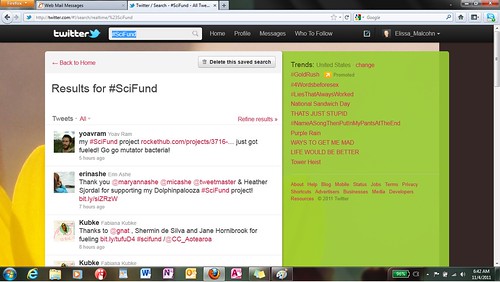
All three tweets shown here are from scientists thanking citizen funders. There's been a lot of that lately, which is not only a happy thing, it's also a plot point. These tweets are like video stills that create a moving picture over time. They are snapshots of the story I'm working to develop.
Fabiana Kubke's tweet relates to Daniel Mietchen's project, "Beethoven's open repository of research." Taking his lead from Beethoven, who said, "There should be only one repository of art in the world, to which the artist would donate his works in order to take what he would need," Mietchen applies that principle to research. He wants to make thousands of scholarly articles easily accessible -- to anyone -- by creating and maintaining a central repository. This is open science, a way in which scientific developments are shared with the world in realtime. It's a new approach toward collaboration and transparency.
Erin Ashe is thanking funders of her project, Dolphinpalooza. She tracks Pacific white-sided dolphins, setting out in a little boat with her dog, who is her able assistant and dolphin detector. Co-founder of Oceans Initiative, Ashe is seeking funds to help her keep working in the field, using non-invasive photo identification and statistical research to learn whether those dolphins are declining, endangered, or in good shape, and how well they and humans are coexisting on the water.
Yoav Ram needs to get to a conference to present his findings on how bacteria react to stress. His mathematical models show where conventional wisdom may have gone astray, and may explain why bacteria become antibiotic-resistant so quickly. Their mutations and evolution may also have implications for cancer treatment. Funds will help him travel from Israel to next year's Population Genetics Group meeting in Nottingham.
But what was happening before #SciFund started getting attention from sites like BoingBoing?

In the beginning I started listing my various collected links on Dipity, a free site that generates timelines complete with live links. That seemed to me a pretty cool organizational tool.
This screen shot shows the timeline roughly ten days before #SciFund's launch on RocketHub. Most of the links are to tweets made by #SciFund participants, who at that time were engaged in 28-hour days (by my estimation) preparing their proposals and videos for upload.
But there are other links in there, too. Like a tweet from The Journal Lab, which helps researchers collaborate and work with published papers more easily. "Crowdfunding is becoming key in the arts, could it become key in science?" they tweeted, adding, "Do we have crowds?!?"
While the scientists involved were sweating over their presentations and gaining a pre-launch audience -- that #oss2011 hashtag on the timeline at bottom right points to this year's Open Science Summit, where #SciFund co-founder Jai Ranganathan wowed the crowd -- I could feel that pre-launch tension building. Would this thing work? Were enough funders out there?
Is there suspense in this nonfiction tale? Heck, yeah! If I were writing fiction, I'd have to figure out where and how to build that tension, creating it out of whole cloth. Here, those on the front line are doing it for me. I just need to organize the data.
Dipity seemed a perfect vehicle, and I love the timeline concept. Except that, at least on my computer, it is glacially slow.
When I realized that impracticality, I turned to its List mode and started doing screen captures, which I assembled in MS Paint.
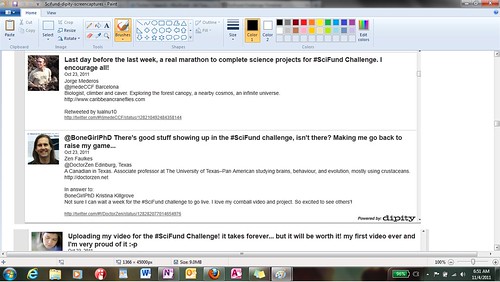
Unlike the timeline bubbles, Dipity's List mode shows the full listing, including the cross-references I included: who replied to whom, who retweeted whom. Yes, I was over-preparing, but only because doing so is far better than under-preparing. It's why raw data is called raw data -- because that's how I felt after wrestling with Dipity.
I wasn't the only frustrated person out there. At the bottom of the screen capture is Marisa Alonso Nuñez, who was having a devil of at time uploading her first-ever video, for her project "Cancer? Yeast has answers." She needs funding to get the antibodies that will let her study the effects on one of cancer's major players, a protein called Polo Kinase. Why yeast? Because the neat thing about Polo Kinase is that it ranges throughout the evolutionary spectrum from yeast to humans, and yeast is much easier to study. (Watch her video. She makes a great analogy that transforms biology into a travelogue.)
Meanwhile, Dr. Zen tweets that he has to raise his game. Sitting in my studio, I get to eavesdrop on the friendly competition and mutual inspiration that goes on in the days leading up to launch. I get to have fun being a nosy parker. If you missed my plug for Dr. Zen's Amazon (a.k.a. marbled) crayfish adventure in my prior entry, go see! He needs travel funds to pursue its cousin, the slough crayfish. His mission: find ways to control an invasive species that clones itself.
It makes sense that Jorge Mederos, cheering the others on in his tweet, is at the top of the screen capture, considering the time he spends up in the tree canopy outside Barcelona. His project, "Can we save Collserola Natural Park?", examines the stresses on "an 85 square kilometer island of nature surrounded by urban sprawl." Funds will help him track environmental data and study insects threatening the trees in this isolated Eden, in the hopes of restoring balance.
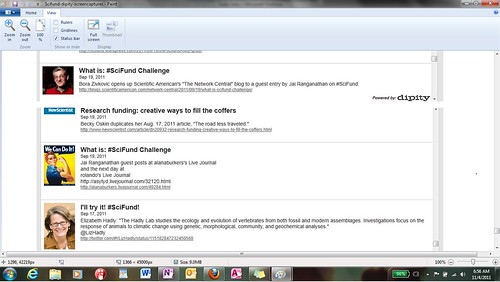
Farther back in the timeline, preparations for #SciFund were just starting to heat up. This screen shot dates to mid-September, when Bora hosted Jai over at Scientific American's "The Network Central" blog. On September 19, New Scientist posted an encore of Becky Oskin's August 17 article, "The road less traveled," renaming it "Research funding: creative ways to fill the coffers," with a nod toward #SciFund.
September was Jai's month for blog tours. His promotion of #SciFund, then still open for sign-ups, kept popping up on the Web.
One of those sign-ups was Elizabeth Hadly, who tweets at the bottom of the screen shot, "I'll try it!" If you missed my plug last entry for her lab's "Species in Peril," go see! Her team needs funds to monitor species at risk of losing their genetic diversity, which helps them adapt to a changing environment.
While great for preserving tweets and cross-references where I can access the text easily, Paint doesn't allow for live links. But OneNote does.
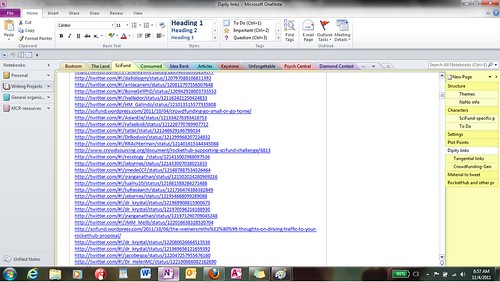
I've got a lot of live links to tweets. (And blog entries. And articles.) And after I gave up on Dipity, I started selectively annotating them (in black type):

Once all the projects went live and I could finally read about them, I started making thematic connections that I want to play with. This OneNote page holds reminders to myself.
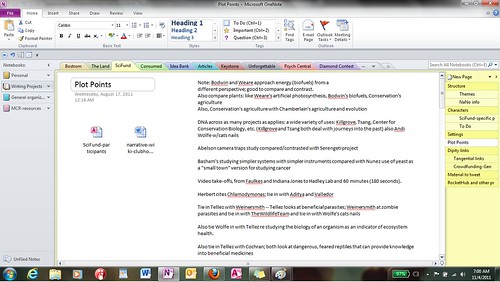
The page also contains embedded links to files on my computer: an Access database file and a Word file. The Word file contains catch-all bits of draft and is one of many text files I'm working on for this project. Here's the Access file:
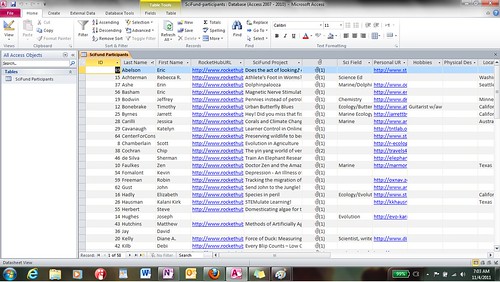
This database lists all the participants, the names and URLs of their projects, associated websites, and several other, largely empty fields that I may not need quite as much, given the info that the others contain. Together, this Access file and OneNote comprise my NaNo Central. They let me call up files and websites at a glance. In the Access file, to the right of the project names, is a column affording me direct access to my text files.
I'm also tracking the fundraising, entering each day's data around midnight, give or take a half hour or so:
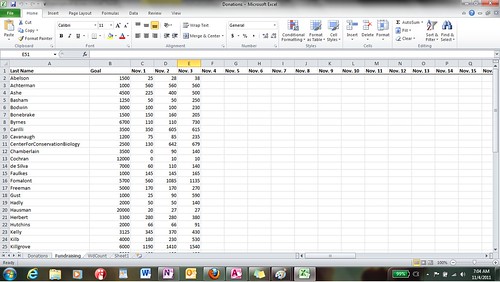
This is also to help me figure out where to send rocket fuel. Part of me wants to help boost each project. Another part wants to concentrate more on those projects whose funding lags behind.
I've had a couple of episodes where I've had to chase down my files, because anchoring them in OneNote and Access puts updated versions in exotic subdirectories, rather than in the subdirectory where I want them to be. After a couple of scares ("But I saved it! Where'd it go?") I'm still learning how to navigate a system I haven't fully grokked yet.
Thank goodness for backups.
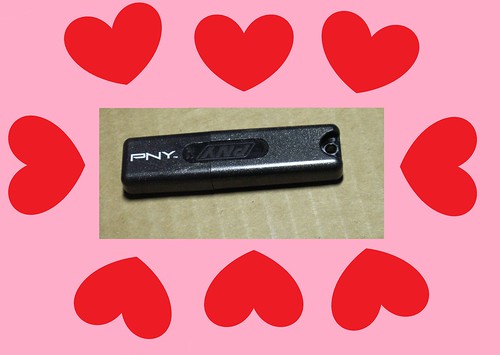
Or, to quote Alison Bechdel's character Mo, "Does 'anal-retentive' have a hyphen?"
Elissa Malcohn's Deviations and Other Journeys Promote Your Page Too 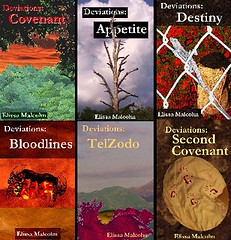
Vol. 1, Deviations: Covenant (2nd Ed.), Vol. 2, Deviations: Appetite, Vol. 3, Deviations: Destiny, Vol. 4, Deviations: Bloodlines, Vol. 5, Deviations: TelZodo, Vol. 6 and conclusion: Deviations: Second Covenant. Free downloads at the Deviations website (click here for alternate link), Smashwords, and Manybooks. 
Proud participant, Operation E-Book Drop (provides free e-books to personnel serving overseas. Logo from the imagination and graphic artistry of K.A. M'Lady & P.M. Dittman); Books For Soldiers (ships books and more to deployed military members of the U.S. armed forces); and Shadow Forest Authors (a fellowship of authors and supporters for charity, with a focus on literacy). 
This work is licensed under a Creative Commons Attribution-NonCommercial-ShareAlike 2.5 License.
I don't have any past NaNo experience to go by, but I know that the way I write fiction is far different from the way I write nonfiction. I think I'd go nuts trying to do regular NaNo.
What's the difference? In my fiction I create from scratch. Here, I'm grabbing hold of information already out there and organizing it, injecting my own spin and my own reactions. When I write fiction I'm like a method actor, struggling to get inside my characters' heads. Here, I'm more like a reporter, still massaging the material at hand, but that means I have ready-made material at hand to massage.
I'm doing research and data collection, but that's different from world-building, which also involves research and data collection, followed by sheer invention. The same goes for story arc. Writing fiction means I'm conscious of my story arc, and I have at least some idea of how to get from Point A to Point B -- though admittedly, my characters often have other ideas and then I have to recalibrate. In my nonfiction NaNo project, the story arc is happening in vivo, and I'm just tagging along for the virtual ride.
Right now, at least, my writing is all about compilation, organization, and commentary. And as such, my preparation was considerably different than if I had prepared to write a novel.
I first learned about the #SciFund Challenge thanks to a tweet in the middle of August from science "blogfather" Bora Zivkovic. (If you have an interest in science, follow this guy.) Ever since then, Twitter has been my main go-to source for #SciFund, not just for its micro-comments but for its article links.
Here's a screen shot from this morning:

All three tweets shown here are from scientists thanking citizen funders. There's been a lot of that lately, which is not only a happy thing, it's also a plot point. These tweets are like video stills that create a moving picture over time. They are snapshots of the story I'm working to develop.
Fabiana Kubke's tweet relates to Daniel Mietchen's project, "Beethoven's open repository of research." Taking his lead from Beethoven, who said, "There should be only one repository of art in the world, to which the artist would donate his works in order to take what he would need," Mietchen applies that principle to research. He wants to make thousands of scholarly articles easily accessible -- to anyone -- by creating and maintaining a central repository. This is open science, a way in which scientific developments are shared with the world in realtime. It's a new approach toward collaboration and transparency.
Erin Ashe is thanking funders of her project, Dolphinpalooza. She tracks Pacific white-sided dolphins, setting out in a little boat with her dog, who is her able assistant and dolphin detector. Co-founder of Oceans Initiative, Ashe is seeking funds to help her keep working in the field, using non-invasive photo identification and statistical research to learn whether those dolphins are declining, endangered, or in good shape, and how well they and humans are coexisting on the water.
Yoav Ram needs to get to a conference to present his findings on how bacteria react to stress. His mathematical models show where conventional wisdom may have gone astray, and may explain why bacteria become antibiotic-resistant so quickly. Their mutations and evolution may also have implications for cancer treatment. Funds will help him travel from Israel to next year's Population Genetics Group meeting in Nottingham.
But what was happening before #SciFund started getting attention from sites like BoingBoing?

In the beginning I started listing my various collected links on Dipity, a free site that generates timelines complete with live links. That seemed to me a pretty cool organizational tool.
This screen shot shows the timeline roughly ten days before #SciFund's launch on RocketHub. Most of the links are to tweets made by #SciFund participants, who at that time were engaged in 28-hour days (by my estimation) preparing their proposals and videos for upload.
But there are other links in there, too. Like a tweet from The Journal Lab, which helps researchers collaborate and work with published papers more easily. "Crowdfunding is becoming key in the arts, could it become key in science?" they tweeted, adding, "Do we have crowds?!?"
While the scientists involved were sweating over their presentations and gaining a pre-launch audience -- that #oss2011 hashtag on the timeline at bottom right points to this year's Open Science Summit, where #SciFund co-founder Jai Ranganathan wowed the crowd -- I could feel that pre-launch tension building. Would this thing work? Were enough funders out there?
Is there suspense in this nonfiction tale? Heck, yeah! If I were writing fiction, I'd have to figure out where and how to build that tension, creating it out of whole cloth. Here, those on the front line are doing it for me. I just need to organize the data.
Dipity seemed a perfect vehicle, and I love the timeline concept. Except that, at least on my computer, it is glacially slow.
When I realized that impracticality, I turned to its List mode and started doing screen captures, which I assembled in MS Paint.

Unlike the timeline bubbles, Dipity's List mode shows the full listing, including the cross-references I included: who replied to whom, who retweeted whom. Yes, I was over-preparing, but only because doing so is far better than under-preparing. It's why raw data is called raw data -- because that's how I felt after wrestling with Dipity.
I wasn't the only frustrated person out there. At the bottom of the screen capture is Marisa Alonso Nuñez, who was having a devil of at time uploading her first-ever video, for her project "Cancer? Yeast has answers." She needs funding to get the antibodies that will let her study the effects on one of cancer's major players, a protein called Polo Kinase. Why yeast? Because the neat thing about Polo Kinase is that it ranges throughout the evolutionary spectrum from yeast to humans, and yeast is much easier to study. (Watch her video. She makes a great analogy that transforms biology into a travelogue.)
Meanwhile, Dr. Zen tweets that he has to raise his game. Sitting in my studio, I get to eavesdrop on the friendly competition and mutual inspiration that goes on in the days leading up to launch. I get to have fun being a nosy parker. If you missed my plug for Dr. Zen's Amazon (a.k.a. marbled) crayfish adventure in my prior entry, go see! He needs travel funds to pursue its cousin, the slough crayfish. His mission: find ways to control an invasive species that clones itself.
It makes sense that Jorge Mederos, cheering the others on in his tweet, is at the top of the screen capture, considering the time he spends up in the tree canopy outside Barcelona. His project, "Can we save Collserola Natural Park?", examines the stresses on "an 85 square kilometer island of nature surrounded by urban sprawl." Funds will help him track environmental data and study insects threatening the trees in this isolated Eden, in the hopes of restoring balance.

Farther back in the timeline, preparations for #SciFund were just starting to heat up. This screen shot dates to mid-September, when Bora hosted Jai over at Scientific American's "The Network Central" blog. On September 19, New Scientist posted an encore of Becky Oskin's August 17 article, "The road less traveled," renaming it "Research funding: creative ways to fill the coffers," with a nod toward #SciFund.
September was Jai's month for blog tours. His promotion of #SciFund, then still open for sign-ups, kept popping up on the Web.
One of those sign-ups was Elizabeth Hadly, who tweets at the bottom of the screen shot, "I'll try it!" If you missed my plug last entry for her lab's "Species in Peril," go see! Her team needs funds to monitor species at risk of losing their genetic diversity, which helps them adapt to a changing environment.
While great for preserving tweets and cross-references where I can access the text easily, Paint doesn't allow for live links. But OneNote does.

I've got a lot of live links to tweets. (And blog entries. And articles.) And after I gave up on Dipity, I started selectively annotating them (in black type):

Once all the projects went live and I could finally read about them, I started making thematic connections that I want to play with. This OneNote page holds reminders to myself.

The page also contains embedded links to files on my computer: an Access database file and a Word file. The Word file contains catch-all bits of draft and is one of many text files I'm working on for this project. Here's the Access file:

This database lists all the participants, the names and URLs of their projects, associated websites, and several other, largely empty fields that I may not need quite as much, given the info that the others contain. Together, this Access file and OneNote comprise my NaNo Central. They let me call up files and websites at a glance. In the Access file, to the right of the project names, is a column affording me direct access to my text files.
I'm also tracking the fundraising, entering each day's data around midnight, give or take a half hour or so:

This is also to help me figure out where to send rocket fuel. Part of me wants to help boost each project. Another part wants to concentrate more on those projects whose funding lags behind.
I've had a couple of episodes where I've had to chase down my files, because anchoring them in OneNote and Access puts updated versions in exotic subdirectories, rather than in the subdirectory where I want them to be. After a couple of scares ("But I saved it! Where'd it go?") I'm still learning how to navigate a system I haven't fully grokked yet.
Thank goodness for backups.

Or, to quote Alison Bechdel's character Mo, "Does 'anal-retentive' have a hyphen?"












1 Comments:
Wow!!!! thanks for this amazing post!!!let's see where the SciFund challenge takes us to!!!
Post a Comment
<< Home